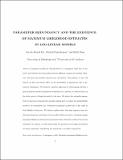Files in this item
Parameter redundancy and the existence of maximum likelihood estimates in log-linear models
Item metadata
| dc.contributor.author | Sharifi Far, Serveh | |
| dc.contributor.author | Papathomas, Michail | |
| dc.contributor.author | King, Ruth | |
| dc.date.accessioned | 2019-10-17T12:30:12Z | |
| dc.date.available | 2019-10-17T12:30:12Z | |
| dc.date.issued | 2021-07-01 | |
| dc.identifier | 251876319 | |
| dc.identifier | d798ba35-f4fc-4c3c-8eaa-e2d4e037cb8e | |
| dc.identifier | 000673915600001 | |
| dc.identifier | 85078660729 | |
| dc.identifier.citation | Sharifi Far , S , Papathomas , M & King , R 2021 , ' Parameter redundancy and the existence of maximum likelihood estimates in log-linear models ' , Statistica Sinica , vol. 31 , no. 3 , pp. 1125-1143 . https://doi.org/10.5705/ss.202018.0100 | en |
| dc.identifier.issn | 1017-0405 | |
| dc.identifier.other | ORCID: /0000-0002-5897-695X/work/96817488 | |
| dc.identifier.uri | https://hdl.handle.net/10023/18698 | |
| dc.description | The work of first author is supported by EPSRC PhD grants EP/J500549/1, EP/K503162/1 and EP/L505079/1. | en |
| dc.description.abstract | Log-linear models are typically fitted to contingency table data to describe and identify the relationship between different categorical variables. However, the data may include observed zero cell entries. The presence of zero cell entries can have an adverse effect on the estimability of parameters, due to parameter redundancy. We describe a general approach for determining whether a given log-linear model is parameter redundant for a pattern of observed zeros inthe table, prior to fitting the model to the data. We derive the estimable parameters or functions of parameters and also explain how to reduce the unidentifiable model to an identifiable one. Parameter redundant models have a flat ridge in their likelihood function. We further explain when this ridge imposes some additional parameter constraints on the model, which can lead to obtaining unique maximum likelihood estimates for parameters that otherwise would not have been estimable. In contrast to other frameworks, the proposed novel approach informs on those constraints, elucidating the model that is actually being fitted. | |
| dc.format.extent | 379360 | |
| dc.format.extent | 346251 | |
| dc.language.iso | eng | |
| dc.relation.ispartof | Statistica Sinica | en |
| dc.subject | Contingency table | en |
| dc.subject | Extended maximum likelihood estimate | en |
| dc.subject | Parameter redundancy | en |
| dc.subject | Sampling zero | en |
| dc.subject | QA Mathematics | en |
| dc.subject | T-NDAS | en |
| dc.subject.lcc | QA | en |
| dc.title | Parameter redundancy and the existence of maximum likelihood estimates in log-linear models | en |
| dc.type | Journal article | en |
| dc.contributor.institution | University of St Andrews. School of Mathematics and Statistics | en |
| dc.contributor.institution | University of St Andrews. Centre for Research into Ecological & Environmental Modelling | en |
| dc.identifier.doi | 10.5705/ss.202018.0100 | |
| dc.description.status | Peer reviewed | en |
| dc.identifier.url | http://arxiv.org/abs/1902.10009 | en |
This item appears in the following Collection(s)
Items in the St Andrews Research Repository are protected by copyright, with all rights reserved, unless otherwise indicated.


